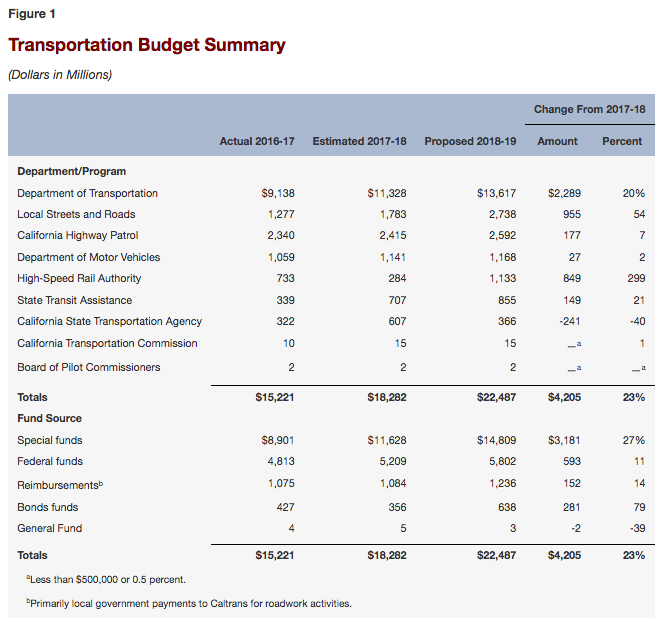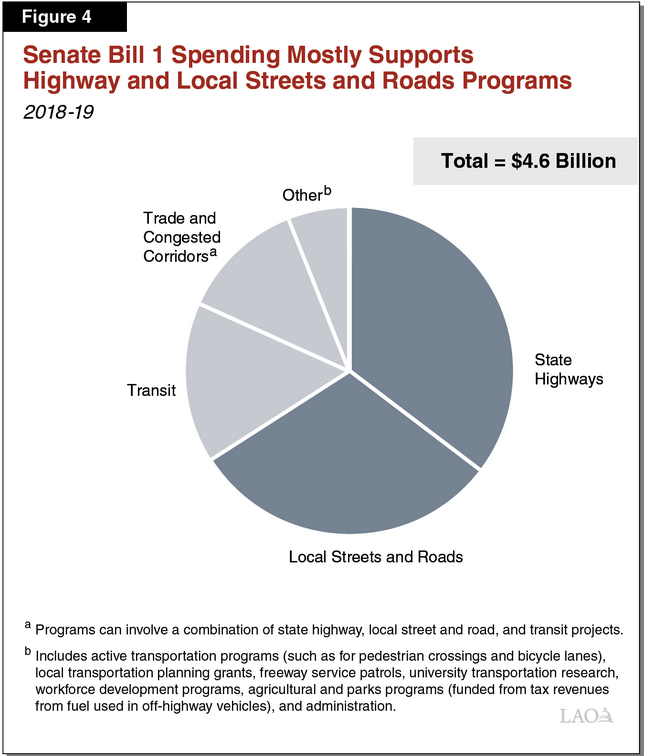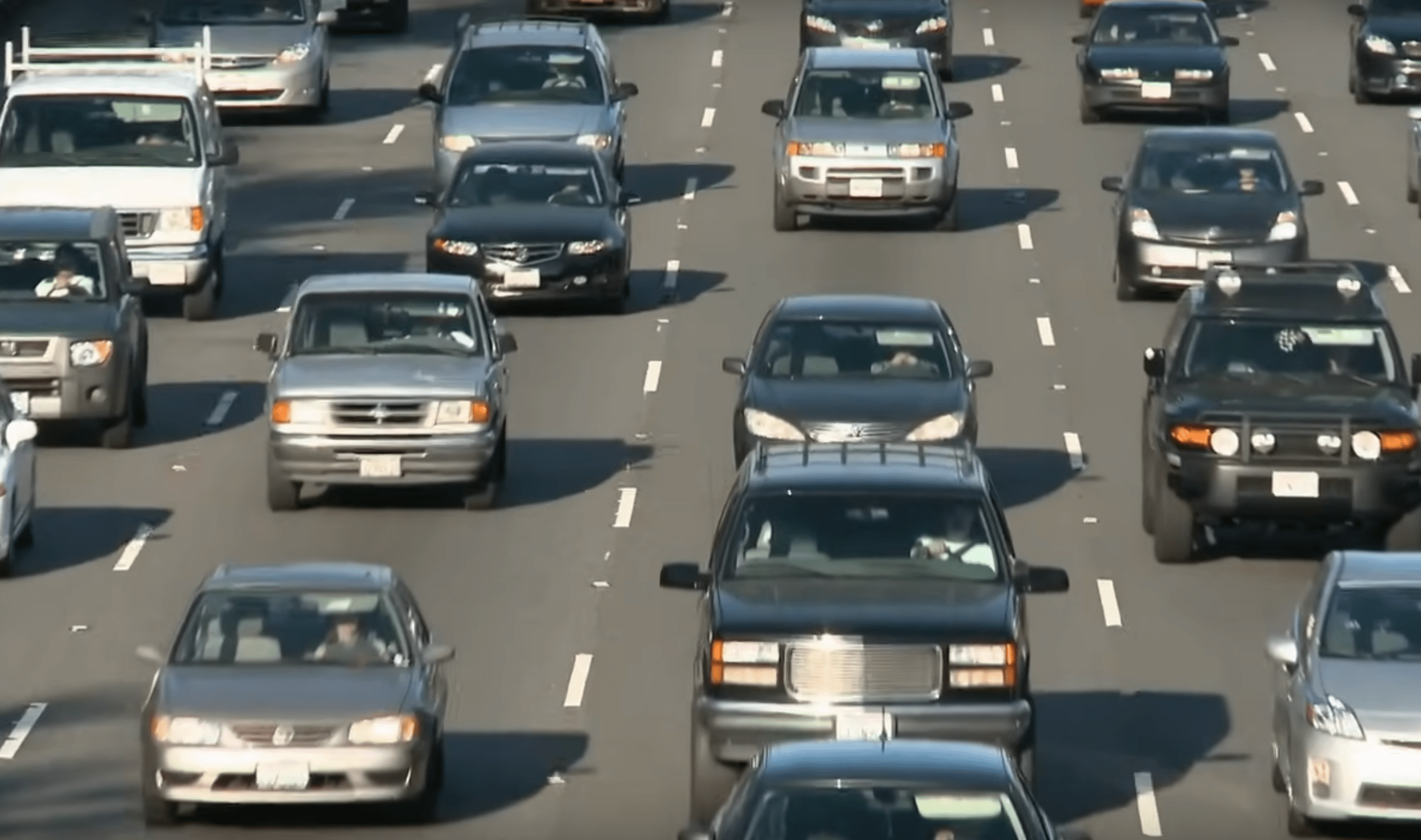The Legislative Analyst's Office, a nonpartisan office that provides fiscal and policy advice to the legislature, released a report focused on proposed transportation expenditures in Governor Brown's 2018-19 budget proposal.
The office recommends that the legislature, as it responds to the governor's proposed budget, prioritize the backlog of road maintenance that has been piling up as transportation funding shrank over the last decade. According to a previous report by the LAO, the state would need $2.6 billion every year for three years just to clear the backlog of road maintenance.
But this year, with the passage of S.B. 1, there is more money for transportation. In January, Governor Brown proposed a total transportation budget of $22.5 billion, from all transportation funding sources, for all transportation departments and programs in 2018-19. This is an increase of $4.2 billion, or 23 percent, over 2017-18.
That $22.5 billion includes about $2.8 billion from new revenues generated by S.B. 1. Those revenues are divided among Caltrans and other programs.
Brown proposes to allocate $2.7 billion for local streets and roads and $1.1 billion for the High-Speed Rail Authority, most of which is from the Greenhouse Gas Reduction Fund, which gets revenue from cap-and-trade.
The total proposed budget for Caltrans is $13.6 billion, a twenty percent increase over this year. About $878 million of the increase is from S.B. 1.
About $1.6 billion from S.B. 1 would be divided between the State Highway Operations and Protection Program (SHOPP) and the Highway Maintenance Program. The SHOPP rehabilitates and reconstructs highways, and can mean replacing roads or bridges or adding new lanes or ramps. The Highway Maintenance Program takes care of minor routine maintenance—such as filling potholes—as well as some larger repairs including repaving.
While S.B. 1 created formulas to distribute its revenues, those formulas do not distinguish between highway maintenance and highway rehabilitation, with that split being left up to annual budget decisions.
Governor Brown doesn't propose an even split; his budget would spend $994 million on the SHOPP, and $576 million on maintenance. But the LAO recommends turning this split on its head. While acknowledging that both programs are important, the report recommends that the legislature “consider modifying the Governor’s proposal to weight additional funding toward highway maintenance, since it can save money in the long term by delaying the need for highway rehabilitation and replacement projects.”
“We recommended the Legislature prioritize new funding for highway maintenance over SHOPP, because Caltrans estimates each dollar of major maintenance funding saves between $4 and $12 by postponing the need for rehabilitation,” reads the report.
The LAO report also says that the administration is pushing to get funding to as many SHOPP projects that are ready to go as quickly possible, with maintenance needs getting whatever money is left over.
Also, it says, “The administration indicates it envisions weighting more funding toward SHOPP in the future as new projects are developed. It believes its proposed level of funding for maintenance in the meantime will help Caltrans catch up on its maintenance work.”
This is a red flag for those who are trying to convince state leaders to shift funding towards more sustainable forms of transportation. The SHOPP frequently includes capacity-increasing projects such as new lanes and ramps that aim to speed up traffic. Caltrans and regional and local agencies say projects like these will “fix traffic” but experience shows that, in the long run, they just make it worse.
Increasing highway capacity is also not going to help California meet its climate change goals. Regions are struggling to find ways to reduce driving to meet those goals, yet they continue to want funding for projects that will produce the opposite results. In the long run, increasing capacity also works against California's ability to maintain transportation infrastructure in a state of good repair. More and wider roads cost more to maintain. This is evident in the maintenance backlog the LAO is pushing the legislature to resolve.
The figure below, from the LAO report, shows how California, despite its stated goals, continues to put more of its money towards facilitating vehicle traffic than towards the modes that can help reduce congestion as well as emissions: transit, biking, and walking.






